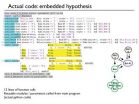(Press-News.org) Scientists at Imperial College London have discovered that iron deficiency may increase stroke risk by making the blood more sticky.
The findings, published in the journal PLOS ONE, could ultimately help with stroke prevention.
Every year, 15 million people worldwide suffer a stroke. Nearly six million die and another five million are left permanently disabled. The most common type, ischaemic stroke, occurs because the blood supply to the brain is interrupted by small clots.
In the last few years, several studies have shown that iron deficiency, which affects around two billion people worldwide, may be a risk factor for ischaemic stroke in adults and in children. How iron deficiency could raise stroke risk has been a puzzle for researchers.
The Imperial team found that iron deficiency increases the stickiness of small blood cells called platelets, which initiate blood clotting when they stick together. Although a link between iron deficiency and sticky platelets was first discovered almost 40 years ago, its role has been overlooked until now.
The researchers studied a group of patients with a rare disease called hereditary haemorrhagic telangiectasia (HHT) that often leads to enlarged blood vessels in the lungs, similar to varicose veins. Normally, the lungs' blood vessels act as a filter to remove small clots before blood goes into arteries. In patients with abnormal lung vessels, blood is able to bypass the filter, so small blood clots can travel to the brain.
The patients in the study who were short of iron were more likely to have a stroke. In addition, the researchers looked at platelets in the lab and found that when they treated these with a substance that triggers clotting, platelets from people with low iron levels clumped together more quickly.
Dr Claire Shovlin, from the National Heart and Lung Institute at Imperial College London, said: "Since platelets in the blood stick together more if you are short of iron, we think this may explain why being short of iron can lead to strokes, though much more research will be needed to prove this link.
"The next step is to test whether we can reduce high-risk patients' chances of having a stroke by treating their iron deficiency. We will be able to look at whether their platelets become less sticky. There are many additional steps from a clot blocking a blood vessel to the final stroke developing, so it is still unclear just how important sticky platelets are to the overall process. We would certainly encourage more studies to investigate this link."
The researchers studied data on 497 patients with abnormal blood vessels in the lung, known as pulmonary arteriovenous malformations, who were treated at a specialist HHT clinic at Hammersmith Hospital. The study found that even moderately low iron levels, around 6 micromoles per litre, approximately doubled the risk of stroke compared with levels in the middle of the normal range of 7-27 micromoles per litre.
Besides this group of patients, many other people have conditions that can allow blood clots to bypass the filter in the lungs. One in four people have a hole in the heart called a patent foramen ovale. Holes in the heart also allow blood to bypass the lung filter from time to time, though not as often as for the lung patients.
The research was supported by donations from family and friends of HHT patients.
INFORMATION:
For more information please contact:
Sam Wong
Research Media Officer
Imperial College London
Email: sam.wong@imperial.ac.uk
Tel: +44(0)20 7594 2198
Out of hours duty press officer: +44(0)7803 886 248
Notes to editors
1. C. Shovlin et al. "Ischaemic strokes in patients with pulmonary arteriovenous malformations and hereditary hemorrhagic telangiectasia: associations with iron deficiency and platelets." PLOS ONE, 19 February 2014. After the embargo the paper will be available at http://dx.plos.org/10.1371/journal.pone.0088812
2. For more information about HHT and pulmonary arteriovenous malformations, see http://www.imperial.ac.uk/nhli/hht_pavm_patient
3. About Imperial College London
Consistently rated amongst the world's best universities, Imperial College London is a science-based institution with a reputation for excellence in teaching and research that attracts 14,000 students and 6,000 staff of the highest international quality. Innovative research at the College explores the interface between science, medicine, engineering and business, delivering practical solutions that improve quality of life and the environment - underpinned by a dynamic enterprise culture.
Since its foundation in 1907, Imperial's contributions to society have included the discovery of penicillin, the development of holography and the foundations of fibre optics. This commitment to the application of research for the benefit of all continues today, with current focuses including interdisciplinary collaborations to improve global health, tackle climate change, develop sustainable sources of energy and address security challenges.
In 2007, Imperial College London and Imperial College Healthcare NHS Trust formed the UK's first Academic Health Science Centre. This unique partnership aims to improve the quality of life of patients and populations by taking new discoveries and translating them into new therapies as quickly as possible.
Website: http://www.imperial.ac.uk
Iron deficiency may increase stroke risk through sticky blood
2014-02-20
ELSE PRESS RELEASES FROM THIS DATE:
Ants build raft to escape flood, protect queen
2014-02-20
When facing a flood, ants build rafts and use both the buoyancy of the brood and the recovery ability of workers to minimize injury or death, according to a study published in PLOS ONE on February 19, 2014 by Jessica Purcell from University of Lausanne, Switzerland, and colleagues. Furthermore, the queen ant is placed in the middle and protected on all sides by the rafting ants.
When put in harm's way, social animals are often able to work together to enhance the survival and welfare of the group. Ants living on flood plains are known to link to together to create rafts ...
Adding bevacizumab to initital glioblastoma treatment doesn't improve overall survival
2014-02-20
Glioblastoma (GBM) is the most common primary malignant adult brain tumor and, despite treatment advances in recent years, the average survival of patients enrolled in clinical trials is less than 16 months with few patients living beyond five years. GBM tumors are characterized by angiogenesis — the formation of new blood vessels that support tumor growth stimulated by the GBM-produced vascular endothelial growth factor A (VEGF-A). Bevacizumab is a monoclonal antibody that targets VEGF-A production to block the growth of tumor-derived blood vessels. "Clinical trials evaluating ...
Bevacizumab offers no benefit for newly diagnosed glioblastoma, MD Anderson-led study finds
2014-02-20
HOUSTON — The angiogenesis inhibitor bevacizumab (Avastin) failed to increase overall survival (OS) or statistically significant progression-free survival (PFS) for glioblastoma patients in the frontline setting, according to a study led by researchers at The University of Texas MD Anderson Cancer Center.
The study appears in the New England Journal of Medicine, and was first presented on the plenary session of the American Society of Clinical Oncology 2013 Annual Meeting by Mark Gilbert, M.D., professor in MD Anderson's Department of Neuro-Oncology.
Glioblastoma is ...
Bevacizumab (Avastin) fails to improve survival for newly diagnosed glioblastoma patients
2014-02-20
BALTIMORE – February 19, 2014. Adding bevacizumab (Avastin) to standard chemotherapy and radiation treatment does not improve survival for patients newly diagnosed with the often deadly brain cancer glioblastoma, researchers report in the Feb. 20 issue of the New England Journal of Medicine.
"We didn't see an improvement in overall survival or a statistically significant increase in progression-free survival, as defined in the context of this trial," says the study's senior author, Minesh P. Mehta, M.B., Ch.B., Professor of Radiation Oncology at the University of Maryland ...
SDSC team develops multi-scale simulation software for chemistry research
2014-02-20
Researchers at the San Diego Supercomputer Center at the University of California, San Diego, have developed software that greatly expands the types of multi-scale QM/MM (mixed quantum and molecular mechanical) simulations of complex chemical systems that scientists can use to design new drugs, better chemicals, or improved enzymes for biofuels production.
A paper outlining the research, titled 'An Extensible Interface for QM/MM Molecular Dynamics Simulations with AMBER' and conducted by members of the Walker Molecular Dynamics Lab (WMD) at SDSC, was featured on the cover ...
Clutter cutter
2014-02-19
WASHINGTON D.C. Feb. 19, 2014 -- Life can be messy at all scales, requiring different organizational strategies -- from cleaning the house, to removing damaged or expired cells from the body to avoid cancer progression.
In a messy house, people use computers to manage paper and photo clutter; companies use computer systems to track their inventory. Now a team of researchers at Vanderbilt University in Nashville, Tenn., is taking a similar approach to cell-molecular inventory control for cancer. They have created computer models, using their programming framework (PySB), ...
Does more stress equal more headaches?
2014-02-19
PHILADELPHIA – A new study provides evidence for what many people who experience headache have long suspected—having more stress in your life leads to more headaches. The study released today will be presented at the American Academy of Neurology's 66th Annual Meeting in Philadelphia, April 26 to May 3, 2014.
For the study, 5,159 people age 21 to 71 in the general population were surveyed about their stress levels and headaches four times a year for two years. Participants stated how many headaches they had per month and rated their stress level on a scale of zero to ...
Insurance status may influence transfer decisions in trauma cases, Stanford study reveals
2014-02-19
STANFORD, Calif. — Emergency rooms are less likely to transfer critically injured patients to trauma centers if they have health insurance, according to a new study by researchers at the Stanford University School of Medicine.
The counterintuitive finding suggests that insured patients are more at risk for receiving sub-optimal trauma care than uninsured patients are.
Although a majority of severely injured trauma patients are initially taken to trauma centers, at least one-third are taken to non-trauma centers. In these cases, emergency room doctors must assess the ...
HPV vaccination is associated with reduced risk of cervical lesions in Denmark
2014-02-19
A reduced risk of cervical lesions among Danish girls and women at the population level is associated with use of a quadrivalent HPV vaccine after only six years, according to a new study published February 19 in the Journal of the National Cancer Institute.
Two HPV vaccines are currently available and have proven to be highly effective against HPV16/18-associated cervical cancer. One of these vaccines, a quadrivalent vaccine, was licensed in Denmark in 2006, and it was subsequently incorporated into general childhood vaccination programs for girls free of charge and ...
Whole genome analysis, stat
2014-02-19
Although the time and cost of sequencing an entire human genome has plummeted, analyzing the resulting three billion base pairs of genetic information from a single genome can take many months.
In the journal Bioinformatics, however, a University of Chicago-based team—working with Beagle, one of the world's fastest supercomputers devoted to life sciences—reports that genome analysis can be radically accelerated. This computer, based at Argonne National Laboratory, is able to analyze 240 full genomes in about two days.
"This is a resource that can change patient management ...


